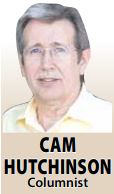
Eunice Gore-Hickman has a special collection of photographs, cherished possessions from a trip to Holland, and a precious pair of salt and pepper shakers in her home.
They are all reminders of her brother Kenneth Scott Ferguson. She was nine years old when Ken enlisted in the Canadian army. Ken, like so many Canadians, lied about his age so he could serve his country. When he enlisted in July 1940, he was almost a month shy of his 15th birthday. Yes, he was 14 years old.
In 1941, he was sent to Europe. He met his two of his older brothers — Russ and Cecil — in London. They must have wondered what their little brother was doing there. Ken’s mother Anna wondered as well. She contacted her Member of Parliament with the hope of having her son, one of her 10 children, returned to Canada. Governments being what they are, Ken turned 17 before the paperwork was completed. At 17, Canadians soldiers were keepers. Ken was now at war. He had taken some training before enlisting. He was what was known as a Saturday Night Soldier. For some, being a Saturday Night Soldier was not taken too seriously. For others, like Ken, it was a time to prepare for battle.

Eunice has a photograph of her three brothers in their uniforms hanging on a wall in her home. It was taken during their get-together in London. All three are good looking men. Ken has a Hollywood handsome face; he was going to be a heart-breaker. He was in London for much of the war before being sent to France a month after D-Day as part of a Replacement Unit. It was there that the teenager from Lanark, Ont., joined the 12th Manitoba Dragoons. Ken was among the Canadian soldiers heavily involved in the liberation of Holland. Ken had the rank of Lance Corporal when his unit liberated a number of towns as it marched toward Germany. The Dragoons were part of a successful offensive in the Rhineland and then regrouped back behind the border to await further orders.
On April 2, 1945, the unit was in the Dutch province of Gelderland. The commanding officer didn’t know precisely where one of his squadrons was. He sent Ken and Lieutenant Maurice Farr to find it. The two went out in a Lynx scout car. It was believed the area was free of German troops. The two arrived near a bridge in a place named Zevenaar. In front of them, there was a railroad crossing with the gate down. Farr, who was driving the vehicle, decided to turn around to bypass the crossing. While turning, civilians ambushed the two Canadians, wounding Farr and killing Ken. He was 19 and engaged, with the wedding scheduled to be held in London later in April during Ken’s leave. The civilians were German soldiers, who were carrying heavy fire power, including an anti-tank weapon. Ken returned fire, but died soon after being hit in the head with a bullet.
Ken died a month before Germany surrendered. He is buried in Canadian War Cemetery Groesbeek. His is one of 2,610 graves. Most of those buried at the cemetery are Canadians. Eunice Gore-Hickman remembers her brother as being a fun-loving kid, then smiled and said, “I don’t remember a lot; I was pretty young then and pretty old now.” She cherishes the photos, and the salt and pepper shakers she has had for 80 years. They were a birthday present from Ken. While talking about her brother, she took the vintage shakers out of her china cabinet. They are treasures.
People in Holland, especially war historian Andre Lefrink, never forgot Ken. On April 2, 2004, 59 years to the day of his death, a bridge in Zevenaar was named in Ken’s honour. It is called Fergusonbrug and is at the site where he was murdered. Eunice and her husband Des were among those at the ceremony. In the time leading up to the dedication, it was not known that Ken had a living sibling. People in Holland were ecstatic when they became aware of Ken’s younger sister. Eunice says she was treated like a queen on the trip. Photos of the event prove it. Hundreds came out to the bridge dedication, including the Canadian ambassador and the mayor of Zevenaar. Paul Workman, then of CBC, reported on the event.

Ferguson’s grave during a trip to Holland in 2004.
On the trip, Eunice visited her brother’s grave. They were close as children, and now she was able to say goodbye at his resting place. Eunice Gore-Hickman is my mother-in-law. I love her dearly and wish I could have met Ken. May he, and all our war heroes, rest in peace.
(Some information for this story was found in numerous media reports, as well as in a research paper titled Kenneth Scott Ferguson: A Bridge to the Past.)
-Cam Hutchinson
